Despite incredible advancements in technology in recent years, most K-12 schools still use massive amounts of paper.
It’s estimated that the average school uses 2,000 pages per day, which quickly adds up to 360,000 pieces of paper over the course of 180 school days.
Between the classroom (handouts, worksheets, tests, homework, report cards, permission slips, etc.) and administration (application forms, student records, newsletters, HR and accounting, etc.), there’s a lot of paperwork to manage and track for administrators, teachers, and students–on top of an already-packed list of responsibilities.
Plus, aside from a substantial environmental impact (the U.S. alone is responsible for 30% of global paper usage), all of those papers cost money. Aside from the cost of the paper itself, paper-based processes also require costs like storage, printer ink, photocopier toner, repairs/maintenance, staples, and more.
With these issues in mind, in this post we’re going to discuss:
- Benefits of Paperless Schools
- How to Become a Paperless School in 4 Easy Steps
- Eight More Ways to Reduce Waste In Schools
Benefits of Paperless Schools
Going paperless has a number of benefits for schools, including administrators, teachers, students, and budgets:
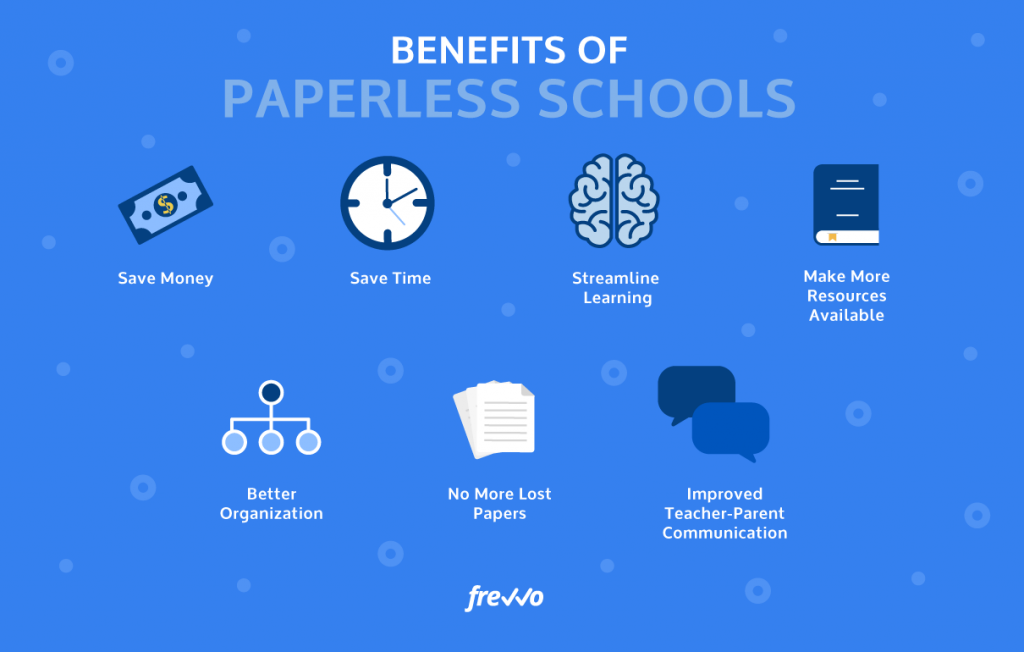
Save Money
All that paper, printing, and photocopying adds up to a significant expense. Going paperless can save school districts upwards of $200,000 per year.
Save Time
In a paperless school, teachers can save a lot of the time formerly spent printing and making photocopies, handing out pages, collecting assignments, and so forth. Instead of paperwork, teachers can spend more time working with their students.
Streamline Learning
With a good digital learning solution, teachers can set assignments and homework online and the system will automatically track whether students have completed their work or not. Even the grading of certain types of tests and assignments can be automated by pre-programming acceptable answers or setting multiple-choice assessments. Submissions of assignments like essays and research projects can be performed online with ease, so there’s no need to print them out.
Make More Resources Available
You can also use online student portals to make a variety of learning formats available (such as podcasts and YouTube videos in addition to online quizzes and assignments) to cater to different learning styles and capabilities. Additional (extra-curricular) resources can also be made available to encourage self-study among curious students.
Better Organization
When all assignments are submitted the same way, it’s much more organized than when some students submit printed copies, others email the teacher, and yet others submit (often indecipherable) handwritten assignments. Aside from making the teacher’s life easier, less paper frees up shelf and cupboard space for other uses and makes for tidier, less cluttered classrooms, creating a more pleasant learning environment.
No More Lost Papers
When homework is completed digitally, the dog can’t eat it. In a paperless school, there’s no risk of an assignment or permission slip or indemnity form going missing – or worse, a stack of ungraded assignments getting lost. There’s always a backup, somewhere.
Improved Teacher-Parent Communication
How many notes from teachers, requests for volunteers, and other paper-based school communications have ended up crumpled up at the bottom of a school bag and never reached their destination? Sending parent communications digitally significantly improves the chances of the parents actually seeing the communication and responding accordingly. As demographics change, digital communication makes it easier to connect with parents in the language of their choice.
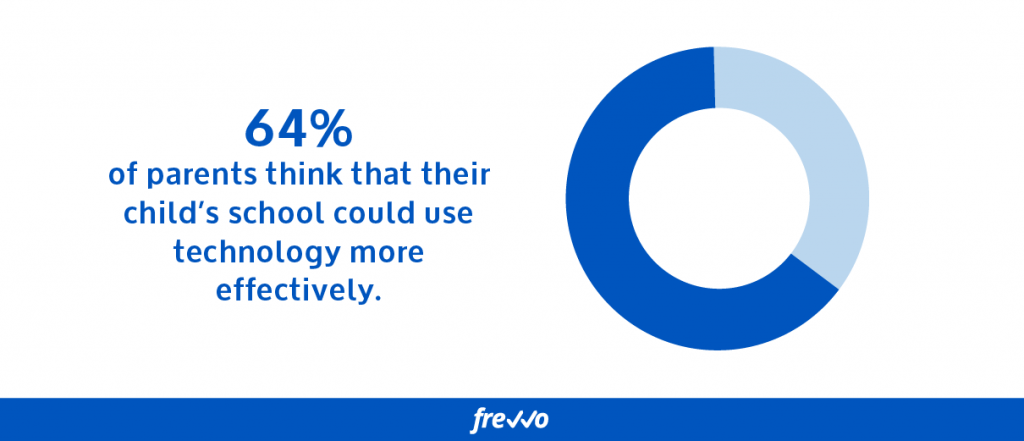
Easier Data/Signature Collection
Implementing digital forms allows schools to collect information, such as student emergency contact information, allergies/medical conditions, parent-teacher meeting schedules, RSVPs for awards evenings, volunteer signups for fundraisers, sports events and school plays, etc. What’s more, digital forms that can capture electronic signatures make it far easier for schools to get important documents like permission slips, indemnity forms, report cards, etc. signed in a timely fashion – especially when they come with automated reminders that prevent parents from forgetting about them.
More Engaged Learners
Today’s students are accustomed to using smartphones, tablets, and personal computers, so using them for schoolwork is a natural progression. Incorporating digital technologies in the learning process inside and outside the classroom can lead to higher engagement levels by keeping students’ attention in a way paper often fails to – particularly when elements of gamification are applied to the learning process.
Moreover, digital learning environments are more equipped to cater to different learning methods and capabilities through a variety of media such as audio, video, and virtual collaboration tools. In fact, teaching children to be comfortable using computers and technology equips them with highly useful skills such as video editing, coding, or simply virtual collaboration skills, all of which set students up for success in later life – an appealing prospect for parents.
Uninterrupted Learning
Paperless schools that already make use of online learning are able to shift to fully-virtual education with relative ease when extraordinary circumstances call for it, whereas schools that rely on paper-based processes struggle to adapt and many schools lose valuable teaching hours as a result.
As you can see, going paperless has many benefits for your school’s administration and education capabilities – not to mention its reputation. Maybe you’ve already decided that going paperless is the right thing to do. But where do you begin?
How to Become a Paperless School in 4 Easy Steps
Going paperless may sound like a daunting task that requires massive investment in technology infrastructure, but it doesn’t have to be.
Whether your school is just starting down the digital path or has already embraced online tools like e-learning and business process automation, the odds are you can benefit from digital tools like school workflow automation software to streamline your processes and go paperless.
1. Identify Your School’s Needs
The first step to successfully transitioning your school to a paperless model is identifying your school’s unique needs. If your school still relies on paper-based processes for everything, your switch to a digital, paperless school will look very different from a school where there’s a laptop on every desk, automated administrative and education workflows, and an established e-learning solution in place.
Start by assessing the current state of affairs to identify areas where you can reduce paper use through digitization and automation.
2. Switch to Paperless Forms
One of the easiest changes you can make in terms of going paperless is replacing all your paper forms with digital forms. Use a forms automation solution like frevvo to access simple drag-and-drop form builders that you can set up in minutes and fully customize to match your existing paper forms.
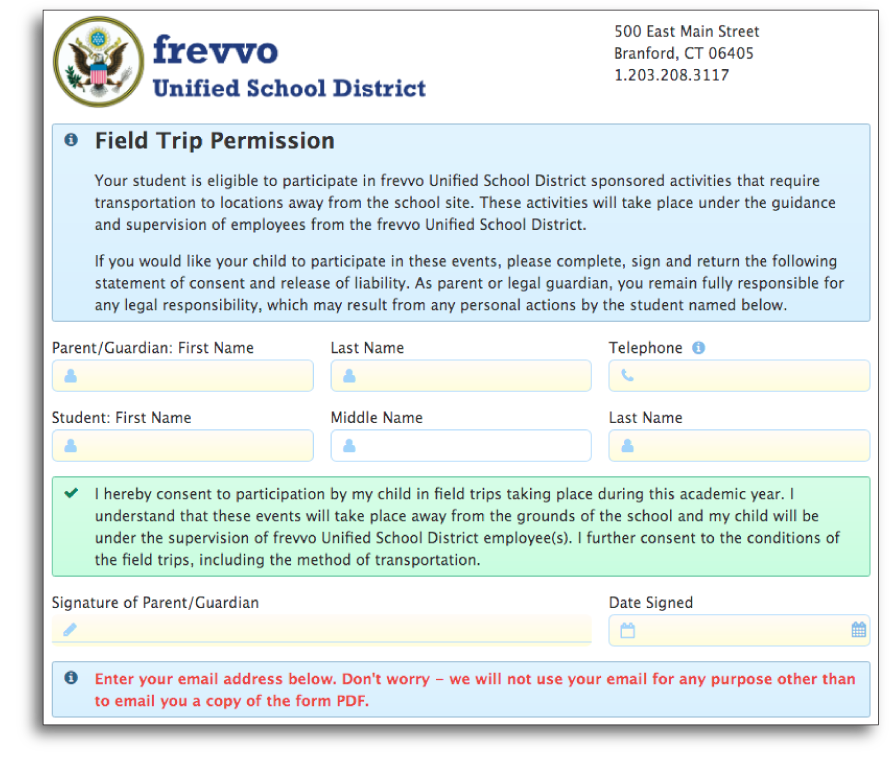
3. Automate Paper-Heavy Processes
By embracing digital forms, you’ve already started down the path of automating your paper-heavy processes. Now you can take those digital forms and set up automated routing that ensures that each form goes where it needs to go when it needs to go there.
Need a parent’s permission for a school outing? With frevvo, it’s easy to set up a permission workflow with notifications and reminders. The parent will receive the form digitally, sign it electronically on any device including their mobile phone, and submit the form.
You can even set frevvo up so that your forms automatically populate your database. No more staff time spent on data-entry and cross-referencing. No more nagging students to return paper slips that they misplaced weeks ago.
You can automate internal workflows like purchase orders, vacation requests, expense claims, and just about any other business process.
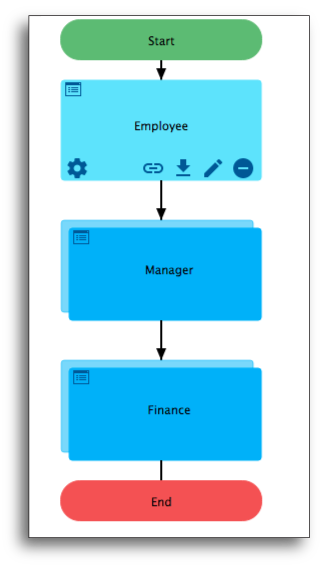
4. Embrace Electronic Signatures
Electronic signatures are a game-changer when it comes to going paperless. Even if you’re already sending documents that need signatures electronically, we’re guessing the odds are that many parents are still returning them as printed documents or printing them at home, signing them, scanning them, and then emailing them back – IF you ever get them back.
With frevvo’s online forms, parents can sign and return forms instantly, making their lives – and yours – easier.
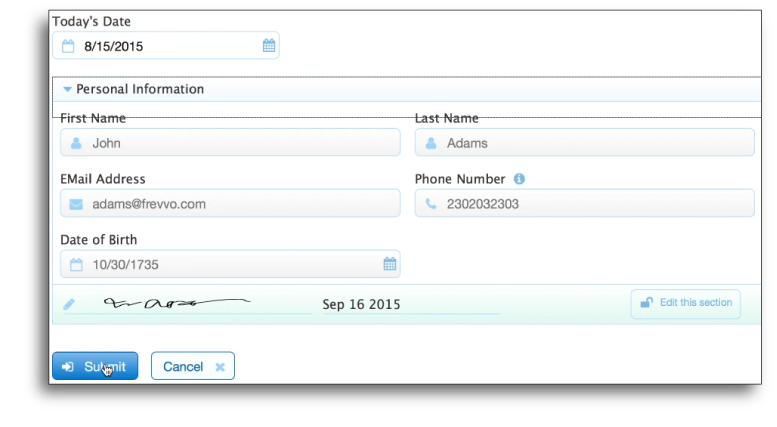
Correctly executed electronic signatures are every bit as binding as a signed piece of paper.
Want to digitize your school’s paper-based workflows?
Forms automation and workflows, digital signatures, and more. Try frevvo free for 30 days. It’s simple — there’s no coding or I.T. required.
Other than automating your internal workflows using workflow automation software, here are some other ways your school can start going paperless:
- Switch to the cloud: when you store all your data and documents in the cloud, you can help eliminate paper waste because everything becomes digital. Apps like Google Drive and Dropbox allow everyone to access documents on their computers or mobile devices so there’s no need to print on paper.
- Digitize paper-based notes, printed teaching material, and paper-based communications such as school newsletters and memos.
- Implement printing and copying quotas and track each person’s usage. You can even use leaderboards to celebrate staff who save the most paper.
- Use paperless statements from banks and service providers
- Embrace e-learning for homework – and even classwork.
Eight More Ways to Reduce Waste In Schools
Schools use a lot of paper on a daily basis, and the reality is that paper-based processes tend to take longer, and they’re bad for the environment.
In addition to going paperless, there are many small changes your school can make to promote sustainability by reducing waste and increasing efficiency. Let’s take a look at a few of the changes you could make:
Recycle Electronics
Most people recycle products like paper, glass, metal and plastic, but recycling electronics is less common, which is concerning given how frequently consumer electronics and office appliances get replaced these days.
In 2012, only 29% of electronics purchased in the U.S. were recycled. In 2017, the UNEP predicted that the world would dump 50 million tons of electronic waste, mostly consisting of smartphones and computers – the equivalent of about 20,000,000 elephants.
To reduce electronic waste in your institution, set up a dedicated bin for electronic waste and have someone collect it and take it to your nearest electronics recycling center monthly.
Some manufacturers even have recycling or trade-in programs where you can receive credits or coupons by bringing back your old electronics. This can save you money as well as reduce waste.
Switch to LED Lightbulbs
Lighting constitutes about 10% of energy use in commercial buildings. One of the quickest and easiest ways to save costs and help the environment is switching the type of lighting you use.
LED lighting is mercury-free, recyclable, and free of the PCB carcinogens found in T12 fluorescent light sources. Compared to incandescent or CFL light bulbs, LED light bulbs last longer without losing quality over time. Even though other types of bulbs might last as long, they tend to dim as they near the end of their lifespan in a way that LED lamps don’t.
LED technology has become much cheaper of late, so that it’s easily the better investment. You can also combine LED bulbs with sensors so that the lights switch off automatically in spaces that don’t need to be lit.
As an added bonus, the type of lighting used in schools can even impact factors like focus and eyestrain, helping you to create an environment more conducive to learning.
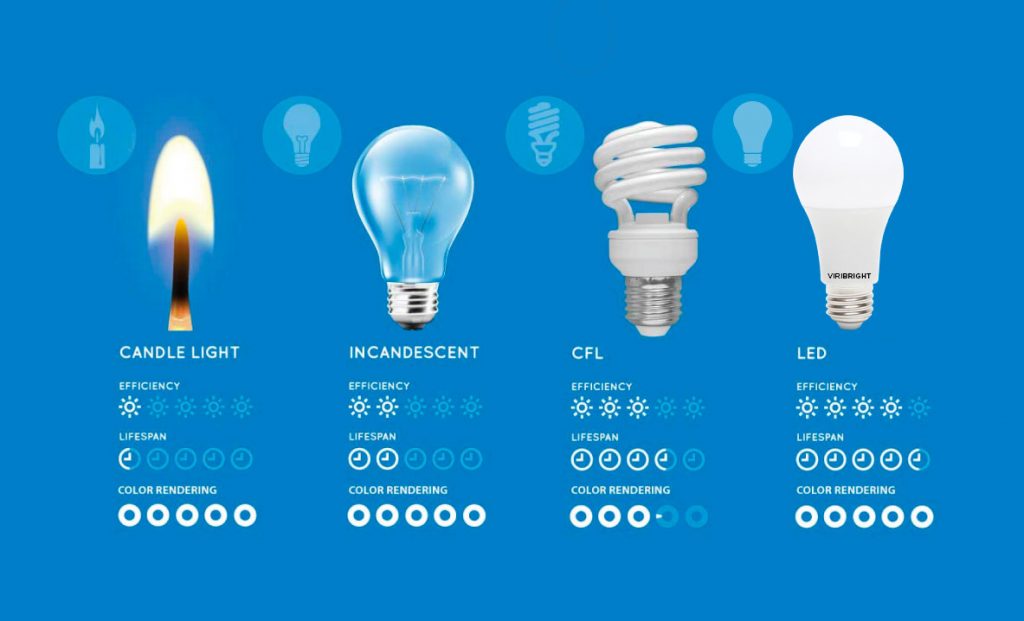
Reduce Printing and Ink Usage
While ink usage is closely related to paper usage, we felt printing deserved a separate mention on account of how bad it is for the environment.
Ink cartridges are particularly dangerous for the environment because one cartridge takes about up to 450 years to decompose. Most ink cartridges in the U.S. get dumped straight in the trash rather than being recycled, which then fills up landfills with 350 million cartridges each year.
Here are some tips for reducing ink waste in your institution:
- Reduce the number of printers
- Only print essential documents
- Use energy-efficient printers
- Always recycle cartridges
Reduce Water-Use
In public buildings like schools, water mostly gets used in kitchens and bathrooms.
Colleges and schools typically have large cafeterias and/or dining halls, and dormitories and athletic facilities offer shower and laundry facilities for students, faculty and staff. All of this can add up to a lot of water usage if you’re not taking precautions to save water.
Here are some tips to make your institution more water-wise:
- Use low-flush toilets
- Use eco-friendly dishwasher and laundry settings
- Use eco-friendly water faucets that regulate water usage
- Add aerators to your faucets to reduce water usage
- Ask students and faculty to report leaky faucets and address drips and leaks immediately.
Provide Sustainable Lunch Options
Team lunches and cafeterias can also be a big source of environmental waste. Schools and colleges in particular often use disposable trays, utensils, and processed foods that often travel far from their source locations. In NYC alone, public schools discard about 850,000 styrofoam lunch trays every day.
Providing vegetarian or vegan options in your cafeterias or participating in initiatives like Meatless Mondays can make your institution healthier and more environmentally-friendly.
Currently, about 83% of global farmland is dedicated to raising livestock for meat consumption and produces 60% of all agricultural greenhouse gas emissions. Research shows that a vegetarian or vegan diet produces fewer carbon emissions, reduces water waste, and even promotes a healthier diet.
Encourage an Eco-Friendly Commute
A recent study in Sweden showed that switching the commute from car to bike produces more than double the effect on the environment compared to introducing congestion taxes. It also resulted in 449 years of life saved annually from reduced exposure to vehicle emissions and improved air quality.
If your city has a bike-sharing program, encourage your employees to participate by providing a commuting stipend – which can also be used for public transportation – or offering membership. If that’s not an option, promote a carpooling schedule to help staff save on gas as well as reduce carbon emissions.
Drink Coffee the Right Way
For large offices that need to serve coffee to many employees at different times of the day, the quickest way is often to use wasteful methods like single-serve espresso machines, which produce a lot of plastic waste through pods. Considering that Americans drink about 587 million cups of coffee each day, that is a lot of waste.
Paper cups are another huge source of waste: Americans throw out 80 billion single-use cups each year.
Not only that, but the process of cultivating and transporting coffee beans can also have a devastating impact on the environment. It can hurt wildlife, ruin habitations, and generate a lot of water waste.
To make sure that your coffee-drinking habits stay as eco-friendly as possible, try:
- Using manual brewing methods for small offices
- Using machines with built-in, reusable filters
- Implementing a policy of using only reusable cups
- Encouraging staff to drink coffee at the office instead of grabbing takeaway coffee on the way to work
- Ordering coffee beans produced from sustainable sources
Join an Environmental Coalition
There’s strength in numbers. Join other organizations participating in promoting corporate environmental responsibility, or join an environmental alliance in your city. If your state or city has governmental programs, set aside a day for your employees to volunteer.
To help you get started, here are some organizations and programs you can check out:
- Green Schools Alliance
- Project Green Schools
- Green Schools National Network
- UN Greening the Blue
- The Nature Conservancy
- Practice Greenhealth
- RecycleMania
Ready to reduce your school’s paper usage and digitize your forms and workflows? Try frevvo free for 30 days.

